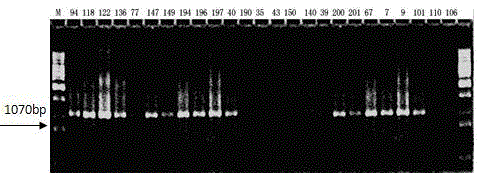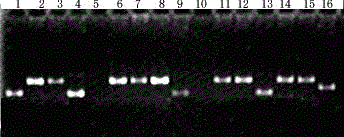Method for identifying cymbidium rapidly
An orchid and plant technology, applied in the field of plant identification, can solve problems such as unclassified
- Summary
- Abstract
- Description
- Claims
- Application Information
AI Technical Summary
Problems solved by technology
Method used
Image
Examples
Embodiment 1
[0152] 1 test material
[0153] The 31 samples tested were all wild orchids in Yunnan Province. All the materials were introduced and cultivated in the orchid garden of the Flower Institute of the College of Garden and Horticulture, Yunnan Agricultural University. There were 9 non-Orchid samples including Orchid and 22 Orchid samples, and a total of 31 samples were used as samples (see Table 1).
[0154] Table 1 Flower name and collection location
[0155] .
[0156] 2 test method
[0157] 2.1 Extraction of orchid genome DNA
[0158] The DNA extraction method was based on the CTAB method for plant genomic DNA.
[0159] 1) The extraction solution, tips, and centrifuge tubes used to extract DAN need to be autoclaved at 121°C (about 1.1kg / cm) for 20 minutes in an autoclave.
[0160] 2) Take 50㎎ fresh leaves and grind them with liquid nitrogen, put them in a 1.5ml centrifuge tube after grinding, add preheated
[0161] 600 μL of 2×CTAB buffer (100 mM Tris-Hcl, pH=8.0; 20 mM...
Embodiment 2
[0309] 1 test material
[0310] The 37 samples tested were all wild orchids in Yunnan Province, of which 14 samples belonged to the subgenus Jianlan, 5 samples belonged to the subgenus Orchid, 11 samples belonged to the subgenus Dahua, and 7 samples belonged to the family Orchidaceae. Genus type (see figure and table number for specific experimental materials). All the materials were introduced and cultivated in the orchid garden in the greenhouse of the Flower Institute of the College of Landscape and Horticulture, Yunnan Agricultural University. The Chinese and Latin scientific names of the samples refer to the nomenclature given by Chen Xinqi (1999) in Flora of China and Chen Xinqi et al. (2003) in "Correction of some taxa in the genus Orchid" in "Journal of Plant Taxonomy", see Table 2.
[0311] Table 2 Orchids ( Cymbidium ) species and some other genera of Orchidaceae collection resource statistics table
[0312] serial number Name Scientific name stat...
PUM
 Login to View More
Login to View More Abstract
Description
Claims
Application Information
 Login to View More
Login to View More - R&D
- Intellectual Property
- Life Sciences
- Materials
- Tech Scout
- Unparalleled Data Quality
- Higher Quality Content
- 60% Fewer Hallucinations
Browse by: Latest US Patents, China's latest patents, Technical Efficacy Thesaurus, Application Domain, Technology Topic, Popular Technical Reports.
© 2025 PatSnap. All rights reserved.Legal|Privacy policy|Modern Slavery Act Transparency Statement|Sitemap|About US| Contact US: help@patsnap.com



